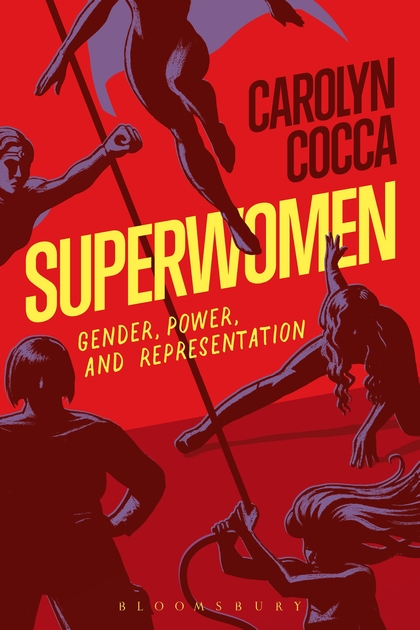Review: Superwomen: Gender, Power, and Representation by Carolyn Cocca
The most prominent stories in contemporary pop culture not only provide a touchstone of well-known entertainment familiar to many, but also unfold in tandem with the society that produced them. They reflect the values, beliefs, and expectations of their creators for our society, and play a part in shaping and changing social norms going forward. For that reason, it is important that these stories are analyzed, evaluated, and critiqued for the themes they contain and the messages they send. Fans, scholars, and other commentators demand that famous franchises do better precisely because of the influence they can wield.
In her book Superwomen: Gender, Power, and Representation, published in 2016 by Bloomsbury Academic, Carolyn Cocca offers such a critique – focusing on the stories of iconic heroines from American comics and related mediums – from the interdisciplinary perspective of a tenured professor of political science. Rather than examine the art, writing, plot, or continuity of the stories on their own terms, Cocca approaches them as the product of power dynamics: who are the creators? who are the consumers? how do changes in the storytelling over time reflect changes in the answers to those questions? All storytelling, including superhero comics, is political – even if some of its consumers or some of its creators think otherwise. And as Cocca demonstrates, the fates of the superheroines she assesses undeniably have ebbed and flowed through exercises of power, whether by writers and artists, editors, consumers, or outside forces.

The opening pages of the introduction, titled “Representation Matters,” lay out the key reasons why inclusion in storytelling makes such a difference. The passages are too lengthy to include in full here, but they are excellent. The points made may be familiar to readers of the book already well versed in the topic; for others, they provide an accessible summary of the foundational ideas. Regardless of one’s background, they serve as a clear, concise, and effective summary before launching into the heart of the book.
A major theme of Cocca’s book, established in the introduction, involves a pair of interrelated points. First, that the significance of individuals from marginalized groups seeing themselves as fictional heroes should not be understated. Second, it is also important that individuals from the historically dominant group – in the case of American comics, white men – have the experience of seeing a wide variety of people, not just people like them, engaging in heroism. Although Cocca’s principal focus is on gender power dynamics and the representation of women, throughout the book she consistently makes reference to other forms of representation where the stories she is analyzing fall short, including race, class, sexuality, and disability.
The other dominant theme of the book is Cocca’s evaluation of the storytelling trajectories of these superheroines to demonstrate that progress toward more representation is not a linear upward path, but rather one fraught with backsliding along the way. The same is true in the history and politics of the United States, of course, where the exercise of power affects far more than the fates of fictional characters – and Cocca compares the influence of, and backlash to, the familiar “waves” of feminism in terms of representation in comics alongside the same dynamics in the broader society. Cocca shows how periods of improved representation of women in comics, on a variety of measures, have been followed by periods of reaction and retrenchment. For example, the transition from broadly targeted newsstand sales of looseleaf issues to the narrowly targeted comic book shop “direct market” corresponded with major negative shifts in the representation of women; the recent evolution of digital distribution is changing the power dynamics once again, as customers left out by the direct market have gained easy access to purchasing comics they support. Cocca frequently uses examples from, and aggregate data about, the letters columns printed in comics issues to illustrate these trends, both the favorable responses to positive representation and the negative reactions of others to the same developments.
Cocca’s six case study chapters illustrate her analysis of power and representation. Most of these superheroines originated in the comics; all have a significant presence in comics as well as in other mediums of storytelling. Wonder Woman and Batgirl have long histories of both positive and negative portrayals over time, following the overall trends in the industry. In addition to representation of women, their stories also illustrate how representation of LGBTQ individuals and persons with disabilities follow similar trajectories. The women of the X-Men – Cocca’s focus is on Jean Grey, Storm, Kitty Pride, Rogue, and Mystique – have been leaders of teams and featured characters, but also sidelined and sexualized. Cocca emphasizes how several iconic comics storylines from the early 1980s that had been centered on the women, such as “The Phoenix Saga” and “Days of Future Past,” were re-centered on men (Xavier, Magneto, and Wolverine) when adapted into movies in the 2000s. The women of Buffy the Vampire Slayer originated differently – on television and more recently – but nonetheless showcase a number of important issues in representation, including gender, sexuality, race, class, and privilege.
The chapter on Carol Danvers evocatively shows how the representation of women can suffer over time, particularly when written almost exclusively by men. She lacks even a consistent superheroine moniker, much less a reliably positive portrayal. Carol’s stories are full of the worst tropes for female comics characters: de-powering, emotional fragility, exhaustion from over-using her powers, longstanding conflicts but few longstanding friendships with other women, dissociative identity disorder, impregnation by rape, and more. More recently, however, her arcs as Captain Marvel by Kelly Sue DeConnick, and the passing of the mantle of Ms. Marvel to Kamala Khan by G. Willow Wilson, have marked a huge stride forward for the character in the comics. Although it precedes the 2019 Captain Marvel movie by several years, Cocca’s book addresses another issue of representation raised by the recent Carol Danvers stories, including the film: the title of Captain Marvel previously held by a black woman, Monica Rambeau, now taken on by a more prominently marketed white woman instead. “[M]ore than most superheroes in this book, debates over race, ethnicity, religion, gender, and heroism through Captain Marvel and Ms. Marvel expose the nexus of the politics of representation and the politics of production and distribution” (page 184).
The chapter on Star Wars considers the characters of Leia Organa, Padmé Amidala, and Jaina Solo from these same perspectives. Leia was a feminist icon in the late 1970s and early 1980s, but also faced backlash and regression, including the infamous Jabba’s slave attire deployed as a means to sexualize the strong-willed character. Padmé reflects the differences in feminism by the early 2000s, but her opening portrayal in The Phantom Menace regresses to primarily a love story with Anakin Skywalker in Attack of the Clones and being sidelined by her pregnancy in Revenge of the Sith. As Cocca sums up, “Increasingly, Padmé’s characterization is narrowed as her story is given over to her relationship with Anakin” (page 101). Cocca also writes that “Padmé and Anakin’s story follows the arc of an abusive relationship and ends with her death” (page 108), and provides an extended analysis of the representational problems with her fate and the manner of her death. Like her forebears, Jaina too is a white cis woman from a privileged background. The flagship Legends stories also did not fare well in other forms of representation, such as race, sexuality, or class. Moreover, Jaina’s storyline was forced into a love triangle trope, just like Leia was on multiple occasions, including the films, original Marvel comics, and several novels. On a more positive angle, Cocca notes Jaina in the Legends tales is surrounded by a wide cast of other female characters. Cocca emphasizes that such a broad cast improves representation because no one character is required to stand in for all women – necessarily true of Leia and Padmé, who were the only starring female characters in their respective films. (Although a similarly broader range of female characters appears in The Clone Wars, Padmé has a much smaller role in the animated series relative to herself the films, or to Jaina in the novels.) The chapter concludes with a brief discussion of the representation in The Force Awakens, but Cocca’s analysis as a whole necessarily focuses on pre-2015 stories.
For someone (like me) not familiar with the decades-long comics histories of the superheroines Cocca analyzes, Superwomen provides an accessible and readable discussion of the rises and falls in their storytelling trajectories. The book certainly lives up to its subtitle, with themes of gender, power, and representation thoroughly examined in each of the case study chapters. In her conclusion, Cocca points to the grounds for optimism in the increasing voices insisting on better representation of superheroines – but also notes the grounds for caution in the patterns of the past as precedent for today’s backlashes. In both storytelling and society, the fight for equality and inclusion still has a long way to go.
- BJ Priester Talks The Acolyte Episode 6 on Who’s the Bossk? - July 7, 2024
- Dave Filoni Talks Writing AHSOKA and Guiding the Future of Star Wars Storytelling - June 21, 2024
- Lessons in Franchise Management – MCU: The Reign of Marvel Studios - January 14, 2024











